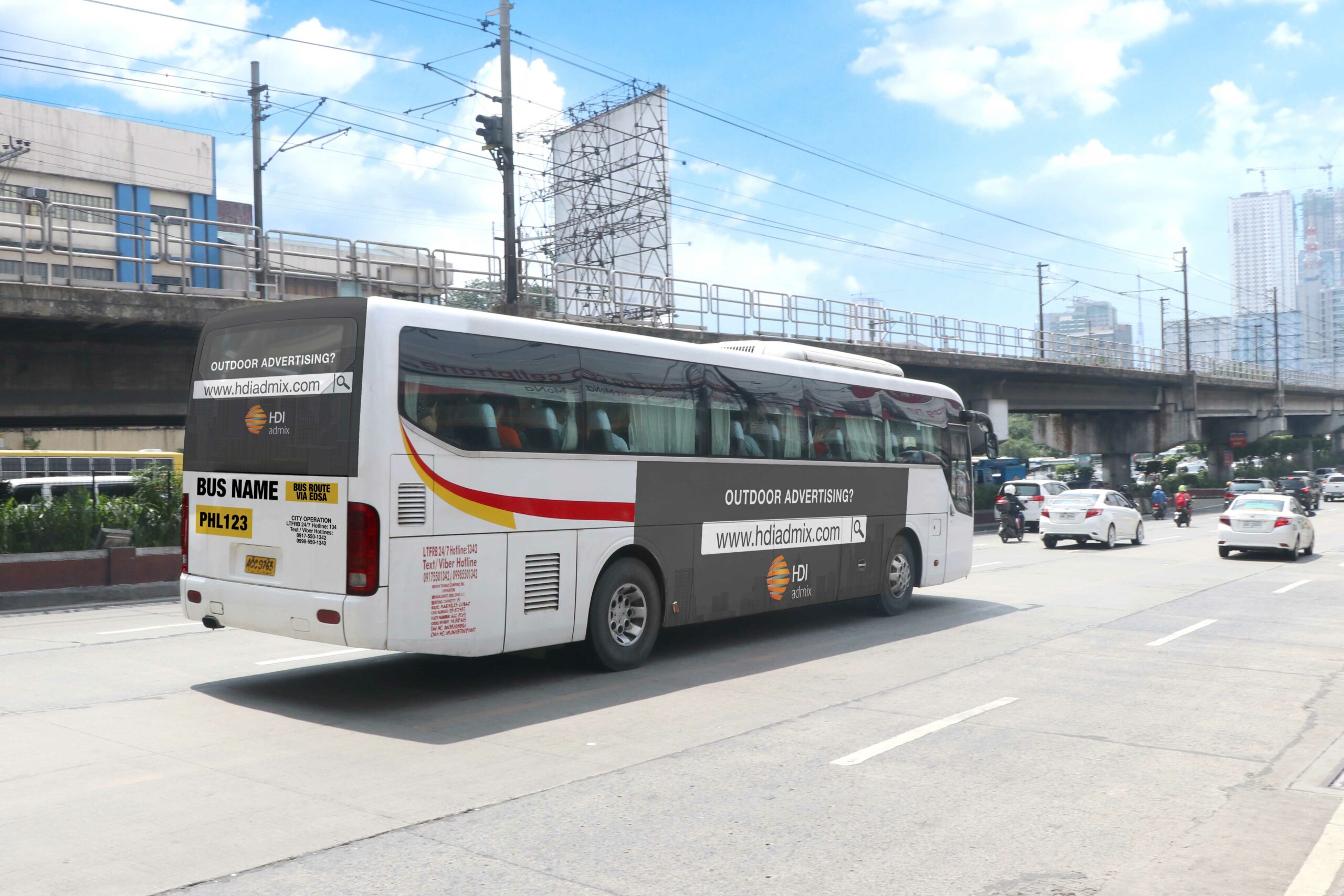Efficient Transit Advertising Philippines to Grow Your Audience
Checking Out the Impact and Efficiency of Transit Advertising in Urban Advertising Techniques
Transit advertising has actually come to be a substantial part of city advertising and marketing strategies, utilizing on the one-of-a-kind characteristics of mass transit settings. Its ability to reach a broad and diverse audience provides brand names with an opportunity to produce purposeful links through consistent presence. Nonetheless, with the quick development of modern technology and shifting consumer actions, the landscape of transportation advertising and marketing is undertaking notable modifications that warrant closer evaluation. What ramifications do these patterns hold for marketing experts seeking to harness the complete capacity of this medium?
The Increase of Transit Advertising And Marketing
As city populaces continue to swell, the demand for ingenious advertising solutions has actually led to the increase of transportation advertising as a critical part of city advertising and marketing approaches. This type of advertising and marketing leverages public transportation systems-- such as subways, trains, and buses-- to reach a varied target market in densely booming areas. The performance of transit marketing depends on its capability to involve consumers during their day-to-day commutes, a frequently neglected yet essential time for brand name messaging.
With cities becoming increasingly overloaded, typical advertising and marketing spaces are ending up being scarce and much less efficient. Transit advertising and marketing offers a vibrant choice, enabling brands to display their messages in high-traffic locations where potential clients are regularly revealed to the ads. Furthermore, as urban locals increasingly count on public transportation, the significance and exposure of transportation advertising and marketing have expanded substantially.
Additionally, technical advancements have boosted the class of transportation marketing, enabling electronic display screens and interactive projects that can capture consumer interest more efficiently than fixed ads. Consequently, transit advertising and marketing is not just an economical choice yet also a vital approach for brands looking for to connect with city consumers in an impactful and unforgettable fashion.
Trick Advantages of Transportation Advertising And Marketing
The effectiveness of transportation advertising and marketing is emphasized by its multifaceted advantages, making it an invaluable tool for urban marketers. One of the primary advantages is its substantial reach; transportation systems serve countless guests daily, permitting brands to attach with a diverse audience in high-traffic environments. This visibility improves brand awareness, making sure that ads are seen repeatedly by travelers.

In addition, transportation advertising is cost-effective compared to other media, supplying a reduced price per impact while keeping high exposure. The versatility of ad styles, from bus wraps to electronic displays, permits impactful and creative campaigns that can adapt to changing market requirements.
Consumer Habits Insights
A significant part of customer actions is influenced by the pervasive nature of transit marketing in city environments. This type of advertising and marketing captures the attention of diverse demographics, engaging consumers throughout their daily commutes.
Research study shows that transit advertising can evoke emotional actions, leading to enhanced brand name fondness. Customers frequently connect the experience of commuting with certain brand names, producing a long-term impact that affects buying decisions. In addition, the regularity of direct exposure to transit ads fosters experience, which is a vital variable in consumer trust and loyalty.

In addition, the communal aspect of public transportation adds to this sensation; as individuals share areas, they are a lot more likely to talk about and recommend brands they come across. Hence, transportation marketing not just gets to customers however likewise boosts social communications that strengthen brand name messaging. Comprehending these behavioral insights permits marketers to customize their strategies effectively, making certain that their campaigns reverberate with target market in the metropolitan landscape.
Case Researches and Success Stories
Effective implementation of transportation advertising and marketing approaches is exemplified through numerous study that highlight its performance in city marketing. One significant example is the collaboration in between a popular beverage firm and a significant city's public transportation system. The campaign utilized bus wraps and interior posters, causing a 30% rise in brand name acknowledgment and a 15% surge in sales within the target market over three months.
Another successful case involved a local restaurant chain that used train station advertising to draw in commuters. By creating aesthetically striking advertisements that provided see here now timed promos, the restaurant experienced an uptick in foot website traffic, with an excellent 25% boost in lunch hour customers.
In addition, a city's tourist board released a transit project showcasing regional tourist attractions via bus quit displays and metro advertisements. The effort caused a significant increase in visitor gos to, as reported by a 40% boost in queries at site visitor centers.
These study underscore the flexibility and capacity of transit advertising and marketing to engage metropolitan target markets properly, showing that calculated positionings can produce considerable rois and improve brand name visibility in bustling urban environments. - Transit Advertising Philippines
Future Patterns in Transit Advertising And Marketing
As metropolitan landscapes remain to develop, so too does the realm of transportation advertising, which is poised to welcome ingenious innovations and techniques. One significant pattern is the combination of digital marketing screens into public transit systems. These dynamic screens permit real-time updates and targeted content, improving target market engagement. In addition, the adoption of programmatic advertising is expected to obtain momentum, allowing marketers to take advantage of information analytics for more specific target market targeting based on time, area, and group insights.
An additional emerging trend is making use of enhanced reality (AR) and virtual fact (VIRTUAL REALITY) experiences within transit advertising. These immersive modern technologies can mesmerize commuters, transforming ordinary Bonuses trips into interactive brand experiences. Additionally, sustainability is becoming significantly essential; environment-friendly advertising materials and practices are most likely to obtain traction, mirroring the expanding customer need for company social obligation.
Lastly, the surge of mobile connectivity will certainly assist in better integration in between transportation advertising and individual tools. Advertisers can produce smooth cross-channel experiences, enabling instant interaction and involvement with potential clients. Jointly, these fads indicate a transformative future for transit advertising, using brand-new avenues for brands to link with city target markets.
Final Thought
Transportation advertising and marketing has established itself as a substantial part of urban advertising and marketing techniques, showing significant performance via enhanced brand name exposure and customer involvement. get redirected here The capacity to adjust messages to specific demographics, coupled with the ingenious usage of technology, positions transit advertising as a driving force in contemporary advertising and marketing (Transit Advertising Philippines). As urban environments continue to evolve, the future of transportation advertising and marketing assures more advancements, ensuring its importance and influence fit customer understandings and behaviors in urban landscapes
As urban populations proceed to swell, the need for cutting-edge marketing remedies has actually led to the surge of transportation marketing as a critical component of city advertising and marketing approaches.A substantial part of consumer behavior is affected by the pervasive nature of transit advertising in city settings. Collectively, these trends show a transformative future for transportation marketing, providing new methods for brand names to connect with city target markets.
Transit advertising has actually established itself as a significant component of city advertising strategies, showing substantial performance via improved brand presence and customer interaction. As urban environments proceed to progress, the future of transportation advertising promises additional improvements, guaranteeing its relevance and impact in forming customer understandings and actions in city landscapes.